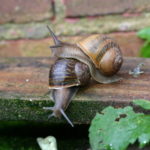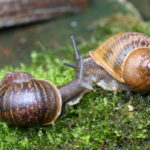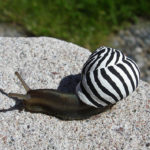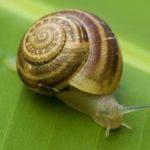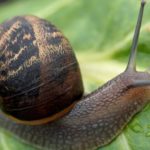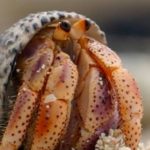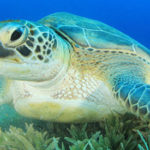Snail Achatina
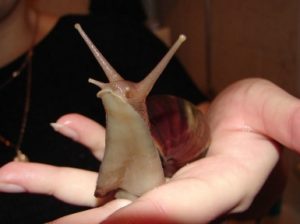 More and more people are appearing who want to keep exotic animals in the house. These are turtles, and skunks, and even crocodiles. One of such popular exotic pets has recently become the African snail Achatina or Achatina giant.
More and more people are appearing who want to keep exotic animals in the house. These are turtles, and skunks, and even crocodiles. One of such popular exotic pets has recently become the African snail Achatina or Achatina giant.
Like all snails, she lives in a shell, but differs from her relatives in the first place. This is a land gastropod mollusk, grows up to 30 cm.
The African snail Achatina is thermophilic and therefore lives in tropical and subtropical regions of the planet. Her homeland is East Africa. But over time, it was distributed in the countries of Southeast and South Asia, in the Pacific, in the United States and South America.
Achatines feel very comfortable at temperatures from +25 to + 30 ° C, but can survive at lower temperatures, but not lower than +2 ° C. The skin and their wrinkled and pimpled. Twisted counterclockwise, the conical thick-walled shell has 7-9 turns. Sometimes there are individuals with a shell twisted clockwise. The color of the shell is brown, the color depends on nutrition and heredity. Stripes are black and light brown. In adults, the shell is green.
Shellfish grow all their lives. But this is especially noticeable in the first two years, and then growth slows down. She breathes air through the skin. Two pairs of horns serve as organs of touch. The first pair has eyes. Snails see only 1 cm, but they can smell cabbage at a distance of half a meter. In captivity can live 5-10 years. With fear, they hide in the sink and squeak. In the wild, these mollusks do not hibernate. Crawl slowly, 1 cm per minute. In nature, snails can be carriers of dangerous parasites. These peace-loving mollusks have enemies, these are: birds, lizards, hedgehogs, moles, mice, toads, frogs, beetles, crickets, millipedes, as well as other snails, for example the gonaxis snail, also found in Africa.
Snails are nocturnal and crawl out after sunset. They live on tree trunks. Young Achatina are harmless and even useful, as they eat rotting parts of plants, and adults significantly harm many cultivated plants, citrus fruits and bananas.
Achatina snails can eat almost anything. They eat corroding plant remains, all kinds of sewage, including animal excrement. They can even completely “rot” rotting trees. It is a kind of nature cleaner. To this end, they began to spread around the world.
So the Japanese in 1938 brought Achatina to the Mariana Islands in order to use them in food. Then, with transported vegetables and fruits, they multiplied on many islands of the Indian and Pacific Ocean. But there was little benefit from it. These gluttonous mollusks spread to tea and rubber plantations and caused great harm there.
But in the USA, brought to California in 1947, they did not take root due to the inappropriate climate. But once in Florida, they became a real national disaster. In just one year, they bred so much that they destroyed everything in that state, and the bark of trees and flowers in the flower beds, and agricultural crops, and even reached the plaster on the houses.
By the way, they needed plaster to restore calcium in the body, so they crawled along the facades of houses licking the walls. It took a long time to get rid of them. Since then, a law has been enacted that all Achatina entering the United States are subject to the death penalty, and that the person who brought them is threatened with a term of 5 years in prison.
However, in some countries they are happy to eat. In 1977, nearly $ 3 million worth of African snails were brought into France (also, check Interesting facts about Marseille). They are bred there now, especially since they are hyperfertile and grow very quickly.
Care and maintenance
Soil is replaced completely once every 20-30 days. And you must make sure that in the terrarium after feeding the snails there is no leftover food that will very quickly begin to rot.
For well-being, Achatina require a constant temperature from + 25 ° to + 30 ° C. For heating the terrarium, you can use a conventional table lamp or a special heater for the terrarium, which can be purchased at any pet store.
You can not heat the snails, putting the terrarium on the window in direct sunlight. Remember that glass enhances the effect of the sun and in the very near future the temperature inside can exceed the acceptable temperature, which will lead to overheating and death of pets.
Snails are very fond of moisture, their health directly depends on this. And in order to create more comfortable conditions, the terrarium should be sprayed with clean water from the spray bottle once a day. And do not forget about the good ventilation of the terrarium in order to prevent waterlogging and development on mold.
Your pet will be very grateful to you for additional water procedures in the form of a warm shower. To do this, the snail should be removed from the terrarium and transferred to the bath. Holding in her hand or placing in any container to direct a gentle stream of water from the shower hose onto it or use a manual spray gun for this purpose. Akhatins take this procedure with great enthusiasm – they are stretched to the full length, trying to substitute as much of their body as possible under the stream of water. The duration of the procedure is 2 to 3 minutes.
Caution: do not put snails in a deep bath for taking water procedures. Their skin takes an active part in moisture exchange with the outside world, that is, actively absorbs water, however, it cannot independently regulate the amount of absorbed moisture. Therefore, the body of a snail from a long stay in a deep bath can literally be filled with water and swell like a sponge. This can lead to fatal consequences.
Achatines are herbivores, because a large part of their diet should be a variety of vegetables, herbs, slices of fruit. You can give them almost all available edible vegetables and fruits, with the exception of very exotic ones. Especially snails like fresh cucumbers, bananas, apples, green salad. In the summer, their menu can be varied with dandelions, clover, plantain, and burdock.
The snail will not refuse protein food: boiled and raw eggs, cottage cheese or yogurt, bread, oatmeal, dry gammarus, minced meat. They will also “gnaw” granules of dry cat food or food for aquarium fish with pleasure.
It should be ensured that there is no Achatine in the diet: sweet, spicy, salty, sour, fried and any products that have traces of mold or rot.
Since Achatina has a sufficiently large shell, which also grows throughout their lives, care should be taken to ensure that their menu is always rich in calcium. To do this, you can add crushed chalk, egg shells, crushed limestone, meat and bone meal directly to food. Or put in a terrarium a whole piece of chalk and mineral pebbles – in pet stores they are sold for parrots, they are also suitable as a mineral additive and a snail.
It is best if the snail menu is as varied as possible, because when feeding with one type of food, there is always a shortage of any necessary elements.
Snails have long-term memory. They clearly remember the time of feeding, so you need to feed them at the same time. Young snails, despite their slowness, can travel considerable distances in search of food. They have no permanent place to rest. The old ones, on the contrary, are tied to a resting place, and do not go to feed more than 5 meters from it. Even if you take Achatina 30 meters to the side, then she will crawl to her favorite place. They also remember their neighbors.
The average life expectancy of Achatina in captivity is 7-10 years. And all this time they are growing. So you have a chance to grow, with good care, a very large and very impressive – especially guests, snail!
Recently, in Russia, there has been a noticeable increase in the “number” of domestic Achatina, so if you decide to have such a miracle in your home, we hope that

